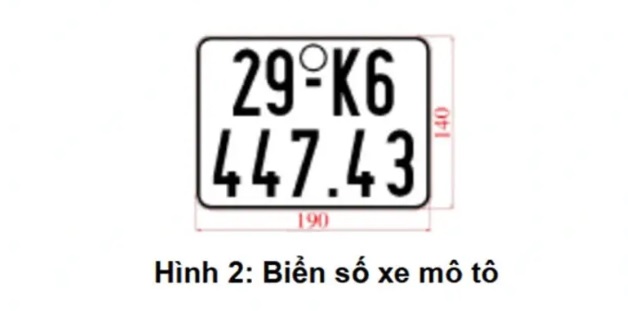The Ministry of Public Security has recently issued Circular No. 81, the National Technical Regulation on Vehicle License Plates, which will take effect from January 1, 2025.
Vehicle License Plate Standards
As per the general provisions, license plates shall be made of aluminum alloy, with reflective film, ink, or paint; a clear and distinct embossed security seal of the Public Security logo; and raised characters, numbers, and symbols with a height of (1.7 ±0.1) mm.
License plates shall adhere to specified dimensions and quality standards, ensuring legibility and security. The characters and numbers shall be well-formed, without smudged ink, and easily recognizable. The reflective film shall be adhered to the aluminum alloy plate without air bubbles.
The arrangement of characters, numbers, and symbols on the license plate shall be balanced and aesthetically pleasing.
For automobile license plates, two plates shall be issued, with all four corners rounded. One plate shall be short, measuring 330 x 165 mm, and the other long, measuring 520 x 110 mm.
On the short plate, the Public Security logo shall be embossed between the two rows of characters and numbers, 5 mm from the left edge.
On the long plate, the Public Security logo shall be embossed above the horizontal line, with the top edge of the logo aligned with the top edge of the row of characters and numbers.
For motorcycle license plates, one plate shall be issued, with rounded corners and measuring 190 x 140 mm, similar to the current standard. The Public Security logo shall be embossed above the horizontal line of the top row, 5 mm from the top edge of the plate.
Circular No. 81 also stipulates that license plates with a white background shall have a black border, characters, numbers, and symbols. Plates with a yellow background shall have a black border, and those with a blue background shall have a white border and characters. License plates with a white background and red characters shall have a black border, numbers, and symbols.
The reflectivity of the reflective film must meet the specified standards. The daytime and nighttime colors of the reflective film shall conform to the regulations. After impact testing, the reflective material shall not exhibit cracks or peel off from the substrate beyond 5 mm from the impact center.
Additional technical requirements pertain to heat resistance, bend resistance, water resistance, cleanability, anti-fogging, corrosion resistance, and durability, in accordance with ISO 7591:1982.
Vehicle License Plate Production Facilities
As per Circular 81, vehicle license plates must be manufactured at core security industrial facilities. The production and supply of license plates shall be in accordance with the requirements of the vehicle registration authority.
License plate production facilities shall maintain a database of production-related information and input relevant data to facilitate management. Every three months, the production facility shall report the results of license plate production and supply, along with data management details, to the Department of Traffic Police, Ministry of Public Security.
Additionally, every three months, the production facility shall randomly select three license plate blanks for sampling and retention. The retention period for these samples is five years from the date of sampling. The original license plate samples shall be permanently stored and preserved at the production facility for future reference in license plate authentication.
The production facilities shall undergo periodic inspections and evaluations every two years. The Department of Traffic Police, in coordination with the Department of Security Industry, Ministry of Public Security, shall conduct regular inspections and evaluations of the license plate production facilities as per the regulations.













































